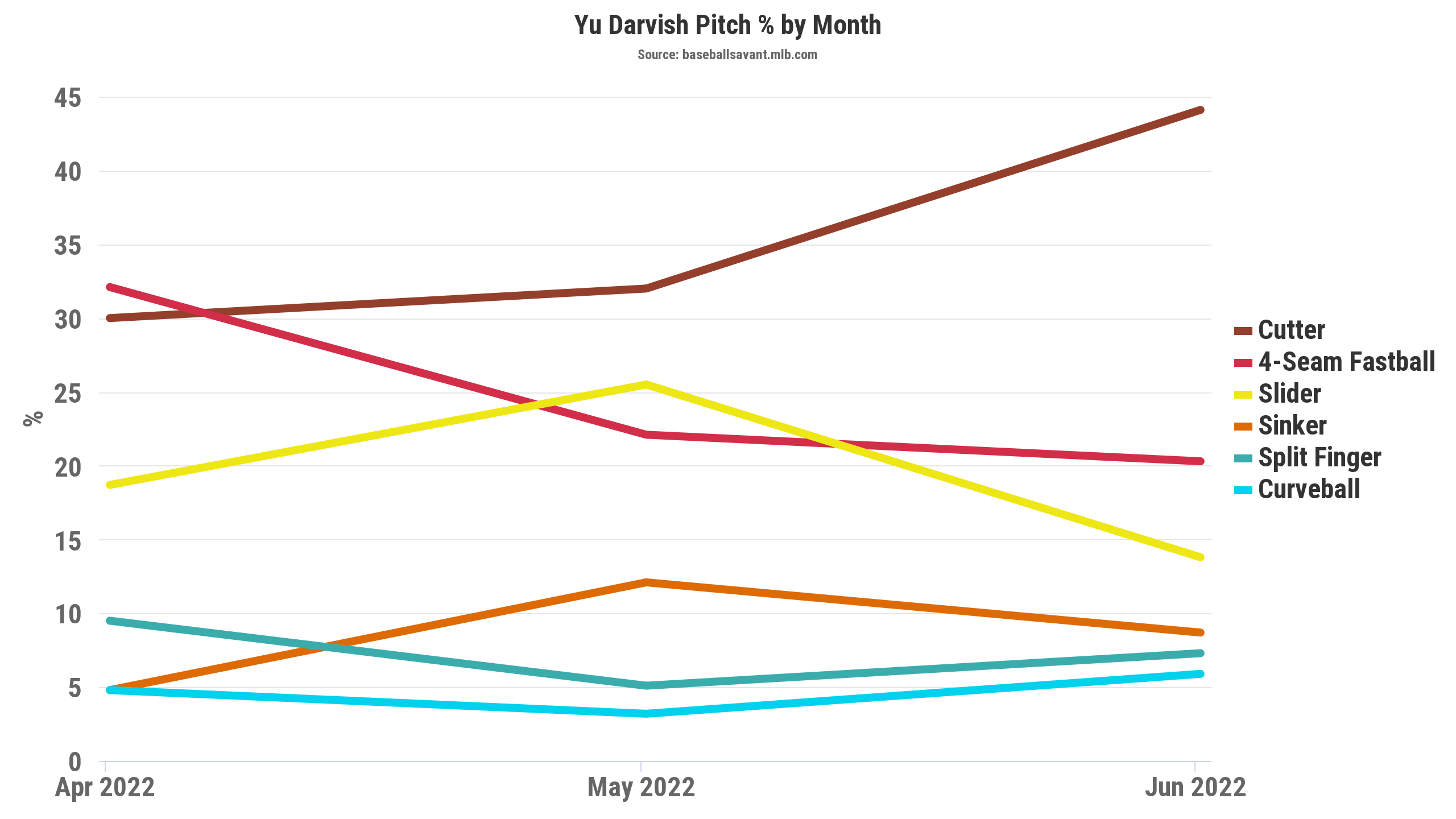Yu Darvish’s second season in San Diego is off to a strong start. Through most of June, Darvish’s top-line numbers are exceeding what he delivered in 2021 and are generally in line with 2019:
Through last Sunday’s start against Philadelphia, Darvish is comfortably in the top 30 qualified pitchers for innings pitched, FIP, and fWAR. He’d been consistent in logging 11 quality starts in his 14 games started. More than that, the run prevention predictors and most of the underlying data support Darvish’s results and suggest that he’s been pitching very well.
Most of the categories in the table above are more or less in line with the previous few seasons. Of course, 2020 stands out as a bit of an outlier across the board, and it’s difficult to know how much stock to put into those excellent numbers from the shortened, mostly warm-weather season.
Compared just to last season, Darvish has made some incremental improvements in limiting walks, getting ground balls, and batting average against, but none of those are significantly different enough to suggest a major change in his approach or ability.
At the same time, the significant changes in his strikeout rate and home runs allowed stand out as something worth digging into. Suppressing walks and home runs, and getting K’s are the fundamental elements we believe a pitcher can control, and the year-over-year changes in those two categories likely hold some insight into what to expect for his performance in the future.
Home Runs
Darvish has a career home run allowed rate of 1.11 per nine innings, almost two times what he’s allowed this season. However, this is the fourth campaign of his career that he’s run an HR/9 significantly below 1.0, so it’s not without precedent that he can occasionally suppress homers very well.
So far this season, Darvish’s 6 home runs allowed have come with a home runs per fly ball rate of just 5.8%, easily the lowest single-season rate of his career and well off his career 13.1% mark. That’s a big part of why Darvish’s 4.02 xFIP – an ERA estimator that assumes league average rates of home runs allowed – is almost a full run higher than his ERA.
Those numbers suggest there might be some regression coming in the home runs allowed department. The counterargument rests in the Statcast data, which suggests that Darvish should have allowed 6.2 home runs this season – almost exactly on the nose with his actual results – based on batted ball exit velocities, launch angles, distances, and park measurements.
So that’s all a bit of a mixed bag. Despite the great marks for suppressing homers, the data does not seem to suggest that he’s been all that lucky in doing so.
Strikeouts
Far more interesting, to me, is the case of Darvish’s strikeouts. Getting whiffs and K’s has always been one of his unique strengths. He was the first pitcher in baseball history to strike out 1,500 batters in fewer than 200 games. He has a career strikeout rate of 29.3%. That number ranks 11th-best among all qualified, active players (3rd-best if you limit to primarily starting pitchers) and he’s punched out more than a batter per inning in every season of his career.
Until now.
This season his strikeouts are down more than a quarter from last season and almost a third from the two seasons before that. It’s the first time he’s ever been below 10Ks per nine innings – and he’s below eight.
That suggests something significant has changed. We can go through all the usual checks to try to explain what’s caused the strikeouts to vanish, but I’ll warn you now that we’ll end up in a somewhat confounded place.
Darvish’s pitch mix and usage rates are nominally the same as in recent seasons – he’s predominantly featuring his cutter (35%), four-seamer (25%), and slider (20%), with a sinker (8%), splitter (8%), and curveball (5%) making up the rest. Compared to last season, though, he’s swapped out a few sliders for four-seamers, but the difference is only 3% and could be explained by platoon reasons.
If anything, he’s throwing a little harder this season. His average four-seamer is 95.2-mph, up a partial tick from last year and the second-highest fastball velocity of his career (2020). The sinker and slider are both up slightly, the cutter and split are mostly the same, and the curveball is about two miles per hour slower.
Usually, when velocity is up and the differential between the top and bottom speeds is wider, we would anticipate there to be more strikeouts — or at least for them to be maintained at the same level as before.
But pitch type and velocity only get you so far. Pitch spin and movement are inextricably linked and play a big role in missed bats. It’s here where there might be some possible explanations for Darvish’s missing K’s. His average spin rates are down across the board from last season’s averages, most noticeably (~100–120 RPM) on his two fastballs and curveball. (If you’re wondering, it does appear that his spin change coincided with the implementation of the sticky stuff ban.)
This lost spin is likely the cause of some meaningful changes in the movement profiles of Darvish’s pitches. Save for his cutter and curveball, Darvish’s pitches are moving less in 2022. That’s especially true of his four-seamer, which has an inch more vertical drop (i.e., it is “rising” less), and his slider, which has lost about an inch and a half of horizontal break. Using Statcast’s Total Movement measurement, you can see the comparison year over year here:
Despite the diminished spin and movement, Darvish is still operating with a strong arsenal. His fastball spin is in the 98th percentile and by Stuff+, the comprehensive measure of pitch quality developed by Eno Sarris and Max Bray for The Athletic, Darvish’s stuff has been about 20% better than average so far in 2022 and improved over the end of last season when it graded out around 12% above average. That’s what makes the disappearing strikeouts so confusing.
From a plate discipline perspective, not much has changed. Darvish’s proportions of pitches inside and outside the strike zone, first-pitch strikes, and swings are more or less the same as ever. One thing that has changed and could explain a fraction of the missing K’s is that batters have been putting Darvish in play earlier in counts — his overall rate of pitches thrown with two strikes is down to 28.5% from 31.2% last season and his early count ball in play rate is up to 14.1% from 12.5%.
A testament to the quality of the stuff, his chase rate is up a bit over last year and right in line with his career average. Nonetheless, batters are not having as much trouble making contact against it. They are making contact on 74.4% of their swings against Darvish, up from 72.7% last year and 67.8% in 2020. The biggest contributor to that is the opposing batter’s sudden ability to get the bat on his out-of-the-zone chase pitches. They’ve made contact on 57.4% of their swings against his pitches out of the zone, significantly more than last season’s 51.8%.
Naturally, then, another big factor driving the lost strikeouts is that Darvish’s overall whiff rate is down to 25.6%. That change looks to be primarily attributable to his four-seamer. After drawing whiffs 34.5% with it last season and 42.3% the year before, this year that number is just 21.8%. Meanwhile, the rest of his arsenal has held steady or improved in the same measure:
The change with the four-seamer is notable because that is his preferred weapon for finishing off a batter with two strikes. This season, he has relied on it with two strikes even more heavily than in the past. Yet, of the 128 times Darvish has gone to the four-seamer in two-strike counts, batters have only whiffed on 14 of them, just more than 10%. Last year that was 18.6%, and in 2020 it was 24.6%.
Logically enough, then, Darvish’s putaway rate – that is, the rate of two-strike pitches that result in a strikeout – with his four-seamer has dropped from 25% to 19%. As Darvish typically tries to work that four-seamer up with two strikes, all of these numbers track with the slightly diminished vertical movement.
Not all is lost, however. With the four-seamer proving to not quite be the weapon it used to be, Darvish has gone away from it more in June, relying more heavily on his cutter instead.

That swap has been true in early counts and also two-strike counts. In turn, the whiff rate on the four-seamer has rebounded to almost 33% overall and 37% in two-strike situations in June. In his last start, he struck out 9 Phillies in six innings of work, just his second outing this season where he struck out more than a batter per inning. It was perhaps fitting that he did so while only throwing 22 four-seamers out of his 102 pitches. Yet, half of the swings against the pitch were whiffs and Darvish punctuated his outing with a perfect, elevated two-strike heater.
https://gfycat.com/agonizingacademicgraysquirrel
In the end, maybe the takeaway for Darvish is again “less is more”. He’s long been a leader when it comes to throwing majority “offspeed” pitches, despite his ability to throw mid-to-high 90s heat. After all, this is a guy widely renowned for his feel who admits that he loves baseball because “I really love to spin the baseball. I love to throw off-speed pitches. Growing up, that was my passion.” Now, maybe a re-doubling of that strategy will lead to the return of his strikeouts.
Featured image by Michael Packard (@CollectingPack on Twitter)

